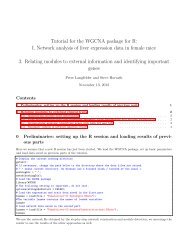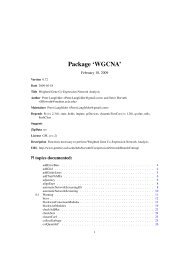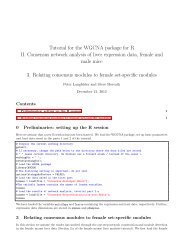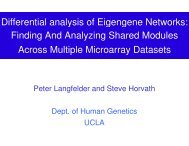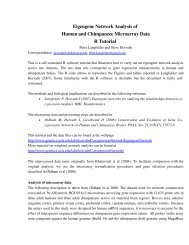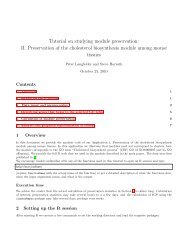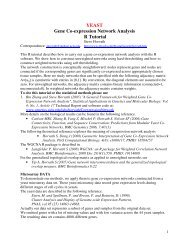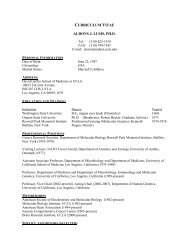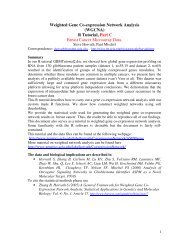Package 'WGCNA' - Laboratory Web Sites - UCLA
Package 'WGCNA' - Laboratory Web Sites - UCLA
Package 'WGCNA' - Laboratory Web Sites - UCLA
You also want an ePaper? Increase the reach of your titles
YUMPU automatically turns print PDFs into web optimized ePapers that Google loves.
18 blockwiseConsensusModules<br />
Value<br />
In the last step, modules whose eigengenes are highly correlated are merged. This is achieved by<br />
clustering module eigengenes using the dissimilarity given by one minus their correlation, cutting<br />
the dendrogram at the height mergeCutHeight and merging all modules on each branch. The<br />
process is iterated until no modules are merged. See mergeCloseModules for more details on<br />
module merging.<br />
The argument quick specifies the precision of handling of missing data in the correlation calculations.<br />
Zero will cause all calculations to be executed precisely, which may be significantly slower<br />
than calculations without missing data. Progressively higher values will speed up the calculations<br />
but introduce progressively larger errors. Without missing data, all column means and variances<br />
can be pre-calculated before the covariances are calculated. When missing data are present, exact<br />
calculations require the column means and variances to be calculated for each covariance. The approximate<br />
calculation uses the pre-calculated mean and variance and simply ignores missing data<br />
in the covariance calculation. If the number of missing data is high, the pre-calculated means and<br />
variances may be very different from the actual ones, thus potentially introducing large errors. The<br />
quick value times the number of rows specifies the maximum difference in the number of missing<br />
entries for mean and variance calculations on the one hand and covariance on the other hand<br />
that will be tolerated before a recalculation is triggered. The hope is that if only a few missing<br />
data are treated approximately, the error introduced will be small but the potential speedup can be<br />
significant.<br />
A list with the following components:<br />
colors module assignment of all input genes. A vector containing either character<br />
strings with module colors (if input numericLabels was unset) or numeric<br />
module labels (if numericLabels was set to TRUE). The color "grey" and<br />
the numeric label 0 are reserved for unassigned genes.<br />
unmergedColors<br />
module colors or numeric labels before the module merging step.<br />
multiMEs<br />
goodSamples<br />
goodGenes<br />
module eigengenes corresponding to the modules returned in colors, in multiset<br />
format. A vector of lists, one per set, containing eigengenes, proportion of<br />
variance explained and other information. See multiSetMEs for a detailed<br />
description.<br />
a list, with one component per input set. Each component is a logical vector with<br />
one entry per sample from the corresponding set. The entry indicates whether<br />
the sample in the set passed basic quality control criteria.<br />
a logical vector with one entry per input gene indicating whether the gene passed<br />
basic quality control criteria in all sets.<br />
dendrograms a list with one component for each block of genes. Each component is the<br />
hierarchical clustering dendrogram obtained by clustering the consensus gene<br />
dissimilarity in the corresponding block.<br />
TOMFiles<br />
blockGenes<br />
blocks<br />
if saveTOMs==TRUE, a vector of character strings, one string per block, giving<br />
the file names of files (relative to current directory) in which blockwise topological<br />
overlaps were saved.<br />
a list with one component for each block of genes. Each component is a vector<br />
giving the indices (relative to the input multiExpr) of genes in the corresponding<br />
block.<br />
if input blocks was given, its copy; otherwise a vector of length equal number<br />
of genes giving the block label for each gene. Note that block labels are not



